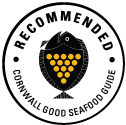

Anchovies are occasionally caught by Cornish ring net fishermen. Famous as the salty little fish you find on pizzas, anchovies are a small oily fish, with a strong flavour. Anchovies are used to add flavour to many dishes and sauces; they can commonly be found as toppings for pizzas, as a key ingredient in Worcestershire Sauce, and are widely used in Mediterranean cooking.
Anchovy are a resilient species and as such can sustain relatively high levels of fishing pressure. However, because they are near the base of the marine food chain, the impact of their large-scale removal on the marine ecosystem is poorly understood. Recruitment to the stock (the process by which young fish join the fishery) is affected by environmental factors including climatic fluctuations. The Anchovies that are caught around Cornwall are likely to be stock from further south that move here with warm water currents in the summer and autumn. The stocks of anchovy in the Bay of Biscay are thought to have increased in ourwaters and are healthy at present and fishing effort in Cornish waters is low.
In 2021 a total of 31 tonnes of anchovies were landed to Cornish ports with a value of £17k (MMO data).
Updated July 2023

Cornish waters VIIe- h
Ring netting is a selective low impact method of fishing for mid water species.
Learn moreCornwall Good Seafood Guide rates fish on sustainability using a scale of 1 to 5.
1, 2 and 3 are recommended, Fish to avoid are rated 5.
We use the system devised by the Marine Conservation Society (MCS) so our scores are comparable with the scores produced by MCS for the UK and fisheries from all around the world. For more information on scoring click here.
Anchovy are a small, silver fish, related to herring. They are a short-lived species, generally living for less than three years. They are found in large shoals, and feed on plankton and small fry (recently hatched fish larvae). They are found in the East Atlantic, principally in the Mediterranean and off the Atlantic coasts of Portugal, Spain and France (although they can be found as far north as Norway and as far south as South Africa). They tend to move north and into surface waters in summer, then retreat and descend into deeper waters during winter. Average size at maturity is 13.5 cm in length; although they can reach 20 cm. Spawning occurs in estuaries and lakes over an extended period from April to November, with peaks usually in the warmest months (June to August in the Channel and southern North Sea, and April to September in the Mediterranean). They are infrequently found by Cornish fishermen but usually in the autumn or winter.
There are currently no restrictions on catches of anchovies in our area. There is no reason to believe that the scale of fishing for anchovy is resulting in overfishing at present. The Anchovies found off Cornwall are likely to be stock from the Bay of Biscay that move here with warm water currents in summer and autumn months.






Cornwall Good Seafood Guide is underpinned by the Marine Conservation Society (MCS) Good Fish Guide. The first UK consumer guide to sustainable seafood. For more information visit www.fishonline.org
Cornwall Good Seafood Guide is here to help us all make sustainable seafood choices. Choices that will help us keep the oceans healthy and Cornish fishers' futures safe. This website is funded by Cornwall Wildlife Trust. If you would like to make a meaningful difference to the health of our oceans, please consider making a donation to the Cornwall Wildlife Trust Ocean Emergency fund. Your donation will help safeguard these remarkable environments, ensuring that they continue to thrive for generations to come. Together, we can be stewards of the seas and champions for a healthier, more sustainable future.